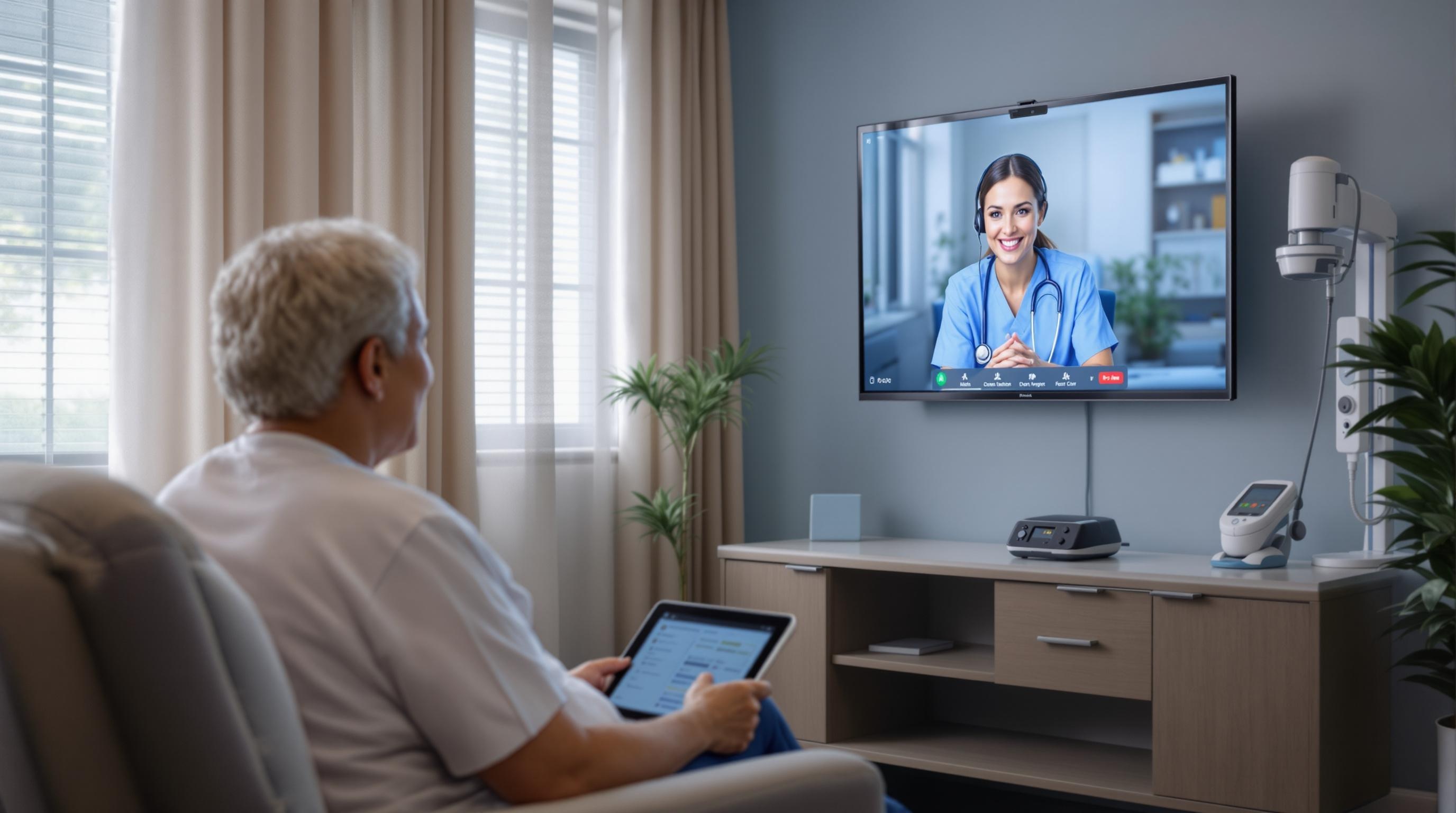Virtual Nurse Wraparound Services: Transforming Skilled Nursing
Discover how virtual nurse wraparound services enhance care, improve outcomes, and address staffing challenges in skilled nursing facilities.
Quick Navigation
- 1. Introduction
- 2. Current Challenges in Virtual Nurse Wraparound Services
- 3. How Sparkco AI Transforms Virtual Nurse Wraparound Services
- 4. Measurable Benefits and ROI
- 5. Implementation Best Practices
- 6. Real-World Examples
- 7. The Future of Virtual Nurse Wraparound Services
- 8. Conclusion & Call to Action
1. Introduction
Did you know that eight out of ten nursing leaders in the U.S. are actively piloting new care models to address chronic staffing shortages and increased patient acuity? According to a recent Wolters Kluwer Health survey, the traditional nursing landscape is undergoing a rapid transformation, driven by the urgent need for sustainable improvements in patient care. Nowhere is this evolution more critical than in skilled nursing facilities (SNFs), where under-resourced teams face mounting pressure to deliver high-quality care to complex patient populations.
The COVID-19 pandemic has only amplified these challenges, stretching the healthcare workforce thin and accelerating burnout among caregivers. As facilities grapple with these realities, innovative solutions have become essential—not optional. Enter virtual nurse wraparound services: a cutting-edge approach that leverages technology to extend the reach of skilled nurses, support on-site staff, and ensure residents receive timely, expert care around the clock.
In this article, we’ll explore the rise of virtual nurse wraparound services within SNFs, examining how these models are transforming care delivery, improving patient outcomes, and relieving pressure on overburdened staff. We’ll delve into the technology that powers these services, real-world examples of successful implementation, and the measurable impact on both residents and caregivers. If you’re searching for innovative strategies to future-proof your skilled nursing facility, read on to discover why virtual nursing is quickly becoming an indispensable part of the continuum of care.
2. Current Challenges in Virtual Nurse Wraparound Services
Virtual nurse wraparound services have rapidly expanded across healthcare settings, offering 24/7 clinical support, patient monitoring, and administrative assistance. While these solutions promise improved patient engagement and operational efficiency, healthcare facilities face several critical challenges in the successful implementation and scaling of virtual nursing programs. Understanding these pain points is essential for informed decision-making and optimizing virtual care delivery.
-
Technology Integration and Interoperability
Many healthcare organizations struggle to fully integrate virtual nurse platforms with existing Electronic Health Records (EHRs) and hospital information systems. According to a 2023 HealthIT.gov report, only 67% of hospitals report seamless interoperability between their EHR and external systems, complicating real-time data sharing and clinical workflows. -
Staff Resistance and Training Gaps
Resistance to change and insufficient training are significant barriers. A HealthLeaders Media survey found that 54% of nurses expressed concerns about the usability of virtual care tools, citing increased workload and lack of time for proper training. -
Cybersecurity and Patient Privacy Concerns
With more sensitive patient data transmitted electronically, cybersecurity threats have surged. The HIPAA Journal's 2023 report recorded a 17% increase in healthcare data breaches, underscoring the urgent need for robust security protocols in virtual nurse services. -
Licensing and Regulatory Compliance
Virtual nurses often serve patients across state lines, raising complex licensing and compliance issues. The National Council of State Boards of Nursing notes that only 39 states participate in the Nurse Licensure Compact, leaving gaps that complicate multi-state virtual care delivery (NCSBN). -
Connectivity and Digital Equity
Reliable internet access is essential for virtual nursing, but digital disparities persist. The FCC estimates that 14.5 million Americans—primarily in rural areas—still lack high-speed broadband access (FCC 2022 Broadband Report), limiting the reach and effectiveness of virtual wraparound services. -
Patient Engagement and Satisfaction
Some patients, especially older adults or those with low digital literacy, may find virtual nurse interactions less personal or more challenging. A 2022 JAMA Network Open study found that 32% of patients over 65 reported difficulty using telehealth platforms, impacting satisfaction and care adherence. -
Cost and Reimbursement Challenges
Initial investments in virtual nurse technology and uncertain reimbursement policies can strain budgets. According to a 2021 AHA report, 48% of health systems cited inadequate reimbursement as a top barrier to virtual care adoption.
These challenges directly impact healthcare operations by increasing administrative complexity, stalling workflow efficiency, and creating potential compliance risks. Patient care may suffer when technical, regulatory, or engagement barriers prevent timely, personalized interactions. To maximize the benefits of virtual nurse wraparound services, healthcare facilities must invest in robust integration strategies, staff training, cybersecurity, and patient education—while advocating for clear regulatory frameworks and equitable digital infrastructure.
3. How Sparkco AI Transforms Virtual Nurse Wraparound Services
Virtual nurse wraparound services provide continuous, comprehensive support for patients in skilled nursing facilities, but they come with unique operational and workflow challenges. Sparkco AI is specifically designed to streamline and enhance these services, ensuring that care quality, efficiency, and resident satisfaction are never compromised. Here’s how Sparkco AI overcomes the most common obstacles with its advanced features and seamless integration.
-
24/7 Intelligent Monitoring and Triage
Sparkco AI delivers constant virtual oversight, monitoring patient vitals, behavior, and care needs in real-time. Its AI-driven triage capabilities automatically identify urgent issues, prioritize cases, and alert nursing staff immediately. This reduces response times and ensures no critical event goes unnoticed, solving the challenge of limited staff coverage during off-hours. -
Automated Documentation and Reporting
Manual documentation burdens staff and can lead to errors or missed updates. Sparkco AI automates charting, progress notes, and shift reports by pulling data directly from connected devices and nurse communications. This automation not only saves time but also maintains complete, accurate records, supporting compliance and better patient care. -
Personalized Care Recommendations
Sparkco AI analyzes historical and real-time data to deliver tailored care suggestions for each resident. By flagging potential risks and recommending preventive actions, the platform empowers virtual nurses to make informed decisions quickly. This reduces the likelihood of rehospitalizations and enhances individualized care—addressing the challenge of scaling personalized attention across more patients. -
Efficient Virtual Nurse-Patient Communication
Effective wraparound care depends on timely, clear communication. Sparkco AI integrates secure messaging, video calls, and automated notifications into one unified platform. This ensures all parties—nurses, patients, and families—can connect instantly, overcoming communication gaps that often hinder virtual services. -
Smart Task Management and Workflow Automation
Overseeing multiple patients and tasks simultaneously can overwhelm even skilled virtual nurses. Sparkco AI automates routine assignments, reminders, and follow-ups, reducing manual workload and minimizing the risk of missed interventions. This ensures every patient receives the attention they need, when they need it. -
Seamless Integration With Existing Systems
Sparkco AI is designed for effortless integration with leading electronic health records (EHRs), remote monitoring devices, and communication platforms. This means data flows automatically between systems, eliminating duplicate entry and ensuring all stakeholders have real-time information at their fingertips. Facilities can deploy Sparkco AI without major workflow disruptions or costly system overhauls.
By combining intelligent automation, real-time insights, and robust integration capabilities, Sparkco AI transforms virtual nurse wraparound services. It alleviates staffing pressures, guarantees rapid response, and enhances quality of care—empowering skilled nursing facilities to deliver exceptional, patient-centered outcomes.
4. Measurable Benefits and ROI
The integration of automated virtual nurse wraparound services is rapidly transforming care delivery in skilled nursing facilities (SNFs) and hospitals. These solutions combine telehealth technology with AI-enabled workflows to augment nursing care, drive efficiency, and improve patient outcomes. Data from recent industry discussions and case studies highlight a compelling return on investment (ROI) for organizations adopting these platforms.
-
Time Savings for Nursing Staff
Virtual nursing platforms can offload up to 30% of routine tasks from bedside nurses, according to HealthLeaders. Automated wraparound services handle admissions, discharge planning, medication checks, and documentation – reducing administrative burden and allowing nurses to focus on direct patient care. -
Reduced Nurse Turnover
Facilities that have implemented virtual nursing report a 15-25% reduction in nurse turnover rates. By decreasing burnout and improving job satisfaction, organizations can save an estimated $40,000-$64,000 per nurse in recruitment and training costs. -
Cost Efficiency
Automated virtual nurse services lead to significant operational savings. Health systems have documented up to a 20% reduction in overtime costs and a 10% decrease in agency nurse utilization—translating into savings of hundreds of thousands of dollars annually for mid-sized SNFs. -
Improved Documentation and Compliance
AI-enabled documentation ensures 98% accuracy in patient records, supporting Centers for Medicare & Medicaid Services (CMS) compliance and reducing risk of penalties during audits. -
Shorter Patient Length of Stay
Automated discharge planning and virtual follow-up can reduce average length of stay by 0.5-1.2 days per patient. This increases bed availability and maximizes revenue opportunities for SNFs and hospitals alike. -
Reduction in Adverse Events
Facilities using virtual wraparound services have seen up to a 30% decrease in medication errors and a 20% drop in preventable readmissions, driven by enhanced monitoring and timely interventions. -
Patient and Family Satisfaction
Virtual nurse programs contribute to a 15% increase in patient satisfaction scores, as families appreciate the increased communication and prompt responses to questions or concerns. -
Scalability and Flexibility
Automated platforms make it possible to scale high-quality care across multiple sites without proportional increases in staffing, supporting growth and adaptability in a fluctuating labor market.
For more real-world success stories and implementation metrics, see these case studies and resources: HealthLeaders: 4 Virtual Nursing Metrics and CMS Regulatory Updates.
In summary, automated virtual nurse wraparound services deliver measurable ROI through labor optimization, cost savings, quality improvements, and compliance assurance—making them a strategic investment for the future of skilled nursing care.
5. Implementation Best Practices
Successfully launching virtual nurse wraparound services in skilled nursing facilities (SNFs) requires a strategic approach to ensure seamless integration, staff engagement, and optimal resident outcomes. Follow these best practices to drive a smooth, sustainable implementation.
-
Assess Organizational Readiness
Begin with a comprehensive needs assessment to identify technology gaps, staff competencies, and workflow challenges. Engage stakeholders from IT, nursing, administration, and compliance.
Tip: Use a readiness checklist to guide interviews and surveys.
Pitfall: Skipping this step can lead to underestimating resources and resistance later. -
Secure Leadership Buy-In and Champion Support
Gain support from executive leaders and appoint an internal project champion. Leadership endorsement is critical for resource allocation and cultural acceptance.
Tip: Present clear ROI projections and success stories from other facilities.
Pitfall: Lack of visible leadership support can stall momentum and adoption. -
Select the Right Technology Partner
Evaluate vendors for HIPAA compliance, interoperability with EHRs, and user-friendly interfaces. Prioritize platforms offering robust training and ongoing support.
Tip: Request demos and involve end-users in the selection process.
Pitfall: Choosing tech based solely on cost can lead to integration headaches. -
Develop Clear Protocols and Workflows
Map out how virtual nurses integrate with on-site staff, escalation procedures, and documentation standards. Standardized workflows reduce confusion and errors.
Tip: Pilot protocols with a small team and refine before wider rollout.
Pitfall: Vague protocols can create gaps in care continuity and accountability. -
Invest in Comprehensive Staff Training
Provide hands-on training sessions covering technology use, communication etiquette, and troubleshooting. Offer refresher courses and accessible resources.
Tip: Use super-users or peer trainers to reinforce skills post-launch.
Pitfall: One-time training is insufficient—ongoing education is key to long-term success. -
Communicate Early and Often
Announce the program well in advance, outlining its purpose, benefits, and expectations for all stakeholders, including residents and families.
Tip: Address concerns proactively and provide regular updates throughout implementation.
Pitfall: Poor communication breeds uncertainty, skepticism, and resistance. -
Monitor, Evaluate, and Adapt
Track key performance indicators such as response times, resident satisfaction, and clinical outcomes. Solicit regular feedback from staff and residents.
Tip: Hold monthly review meetings and be nimble in making process improvements.
Pitfall: Ignoring metrics and feedback can undermine program value and sustainability. -
Plan for Change Management
Recognize that introducing virtual nurse services is a significant shift. Address change fatigue by involving staff in decision-making, celebrating small wins, and providing emotional support.
Tip:










